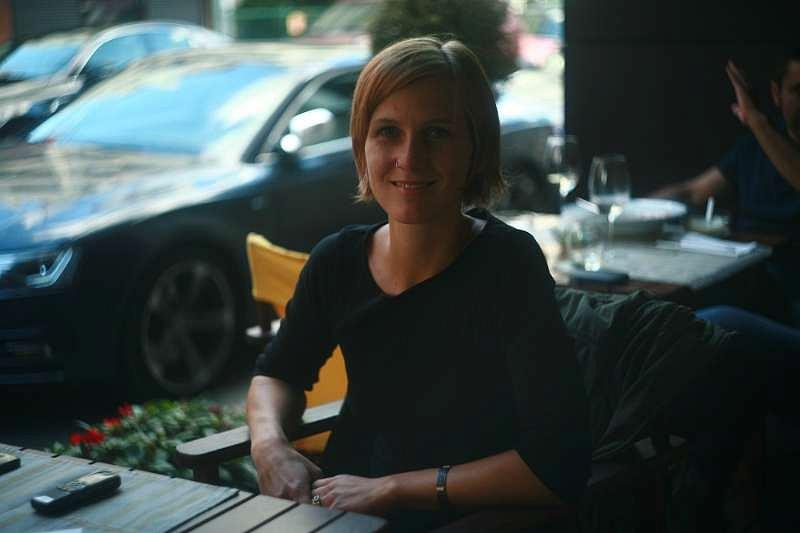A moonstone and colorful cards story with Angie Arndt

A young German woman has put in brackets her normal life for four years and came to Bucharest to make it colorful.
At the table of an Italian restaurant in Bucharest, somewhere between a moss-green broccoli soup and a light-green leek soup, a moonstone ring sends its blue reflections. The Romans admired moonstone, as they believed it was born from solidified rays of the moon. This ring was made by a German goldsmith in Berlin after Angie Arndt’s design, who is now wearing it.
Until two years ago, when Angie moved to Bucharest because of her husband’s job, she was living in Friedrichshain, East Berlin. It’s a peaceful neighborhood, full of bakeries, children's trolleys, young, beautiful parents and a long list of bearded artists.
When she arrived in Bucharest, it struck her how chaotic everything was; beautifully chaotic though, she adds. It took her a few months to get used to new definitions for traffic, parking and doctors; but after this accommodation period, Angie says that she started to be happy here. “Happier than in Berlin? ”Neah…” she answers smiling.
As I first contacted her, she told me that she was having a very busy period, as she needed to bring her youngest son to the kindergarten and spend some hours with him there until he gets used to it, then go to a print shop to see how everything is going for the calendar she is working on.
So when I arrived at the Italian restaurant and had to guess which one was Angie, I was expecting to see a woman in her late 30s. Finally I approached the only German-looking lady from there, blond hair, delicate features, even though she seemed to be too young to be the mother of two kids. But she was Angie indeed.
The ring she was wearing is her engagement ring. She doesn’t talk much about her husband, but she tells me that they both played in a rock band called DK 15. They were covering artists like Led Zeppelin or Neil Young. This is one thing she misses about Berlin. But when they’ll get back there, in two years, probably they will resume playing, she says. For now, she sings in the choir of the German School in Bucharest.
Eve though she worked as a policewoman in Berlin, she always did creative stuff, mostly painting and photography. “It could have been a career, but somehow things went into another direction. I was also a bit lazy,” she says laughing. Now when both her sons, who are five and three , go to kindergarten, she has more time for art. So she came with the idea of creating a calendar made up of postcards.
“I wanted to do something nice and I’ve noticed that Bucharest’s image abroad is distorted. People don’t know much about Romania and what they know results more from the years before the Revolution. I wanted more people to become curious and interested in this.” So she took black and white pictures of emblematic places from Bucharest, such as the House of the Free Press, the Arch of Triumph, the Patriarchate Hill and painted above them, adding colors. It resulted in a calendar for 2014 called “Colourful Bucharest, Postcard Calendar: 12 Photo-Painting-Collages”.
The calendar is made up of postcards, which can be cut out and sent. “I always like it when something is both nice and practical. In Germany it is still popular to send postcards. In Berlin there are so many postcards to buy. Here in Bucharest I haven’t found many which were appealing to me.”
There is also the social dimension of the project, as ten percent of the profit will go to a local NGO called “Chance for life”, which supports HIV-infected orphans and disabled people. “I wish that people supported more, that the social engagement was stronger here.” She also thinks that the state should take a more active social role. “In Germany the social state is much stronger. You cannot compare it, it is simply a different level. There are very well equipped sheltered workshops. ‘Chance for life’ receives no support from the state; there are only donations and project-based financing, nothing certain at the end of the day. It is something that should be in the responsibility of the state,” says Angie.
At three o’clock she needs to pick up her children from the kindergarten and drive again through the insane traffic. “In Berlin you can do everything by bike. After work I used to take my oldest son from the kindergarten and go cycling back home. We were living in a residential complex, with an inner yard, where we knew everybody. Children are very free there. They can go outside whenever they want, and nothing can happen because there is a big gate. They can play alone.”
In Bucharest Angie lives next to the Gradina Icoanei park, where she sometimes takes the kids after the kindergarten, but she always has to watch them. But in the end she likes this city because you don’t feel lost here. “Berlin has such a great offer, it is so creative, that you have the feeling that you cannot see everything, it is too much. Here you have an idea and then you can actually make it happen.”
By Diana Mesesan, features writer, diana@romania-insider.com
(photos by Diana Mesesan)














